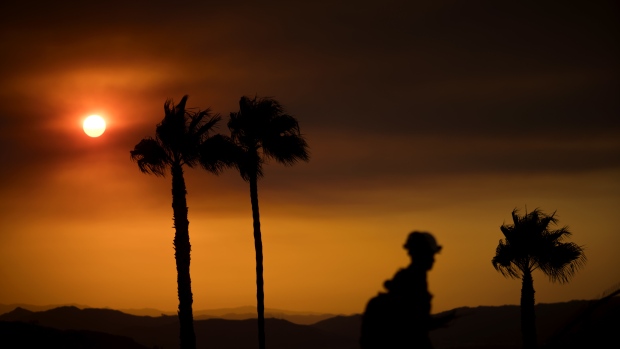Sep 9, 2022
‘All Bets Are Off’ as California’s Wildfire Season Enters Danger Zone
, Bloomberg News

(Bloomberg) -- After a relatively calm start to the wildfire season, California is bracing for things to get much, much worse.
A blistering heat wave and deepening drought have left California tinder dry weeks before the arrival of seasonal hot winds that can quickly whip a spark into overwhelming flames. One utility has already said it may need to cut power to 50,000 Southern California homes and businesses to prevent fires. Such factors are converging to set up the state for a return of the massive blazes, choking smoke and fire deaths that have tormented the region in recent years.
“I am kind of holding my breath,” said Daniel Swain, a climatologist with the University of California, Los Angeles. “If we do get those ignitions and the wind events, all bets are off.”
Such an event would mark a turnabout for what has been a relatively quiet wildfire season in the Golden State. The 272,144 acres burned as of Sept. 8 is well below the 2.32 million acres in the same period a year ago and just 18% of the five-year average, according to the California Department of Forestry and Fire Protection, or Cal Fire. The rest of the US has been more active, with 6.3 million acres scorched nationwide, according to the National Interagency Fire Center. Europe has also seen record numbers of wildfires, with almost three times as much area burned in 2022 than the average over the past 15 years.
Cal Fire said Thursday that about 7,500 firefighters are working on 11 major wildfires and also responded to 33 new blazes across the state.
California’s recent weather has made the region more vulnerable to blazes. The state has endured a heat wave since late August, with record-breaking temperatures above 100 degrees Fahrenheit (38 degrees Celsius) that drove up electricity demand and increased risks of blackouts. The punishing heat is set to linger through Friday before the large high pressure system behind the weather breaks down and clouds and rain from Tropical Storm Kay drift into the region, though conditions for fires across the state remain elevated.
While fires can rip across California virtually year-round, the period from October through December frightens officials and homeowners the most. That’s when larger weather patterns in the US West conspire to create the Santa Ana, Diablo or Sundowner winds that can blast hot, dry air across the parched landscape.
Intense winds like the Santa Ana can spread fire quickly. A doubling of wind speed causes a fire to spread four times faster, said Janice Coen, a project scientist at the National Center for Atmospheric Research in Boulder, Colorado. Santa Ana winds are caused by wind rushing from high-pressure areas inland to lower-pressure zones over the ocean, with wind speeds reaching 100 miles per hour (161 kilometers per hour) in some locations.
“That can both cause an ignition by interacting with utility infrastructure and spreading the fire rapidly once it starts,” she said. “They can spread to 10,000 acres within a few hours. People have said they only have minutes to escape from the moment they see embers coming down.”
Wildfires are one of the most dramatic signs of climate change, with extreme heat and long-lasting drought creating the perfect conditions for infernos. The US Southwest in the midst of the most severe drought in 1,200 years, which has left California with plenty of dried-out vegetation that's ready to burn.
“The potential for damaging fires still remains extremely high,” said Jon Heggie, a battalion chief and spokesman with Cal Fire. “We are really at the mercy of Mother Nature.”
A range of factors — both natural and human — contributed to this year’s slow start for the California fire season, he said. A humid summer dampened fire spread up until Labor Day weekend, when multiple fires broke out across the state. And dry lightning, which sparked some of the biggest fires in recent state history, hasn’t struck with the intensity of past years.
Cal Fire also amped up its response to small fires and this year kept 95% of fires contained to 10 acres or less, Heggie said. He said the department dispatches firefighters and equipment like fire engines and airplanes based on the potential for fire growth and would, for example, respond more aggressively to a small fire on a hot and dry day than on a day when it’s raining.
Still, wildfires have already caused tragic losses in the state this year including killing nine people, according to Cal Fire. Four of those deaths came in fires the began earlier this month, with two in the Mill Fire near the Oregon border and two more in the Fairview Fire near Los Angeles.
“We used to have entire fire seasons that didn’t kill anyone or burn hundreds of homes,” UCLA’s Swain said. “But we have already had a number of fires that have done that.”
©2022 Bloomberg L.P.


